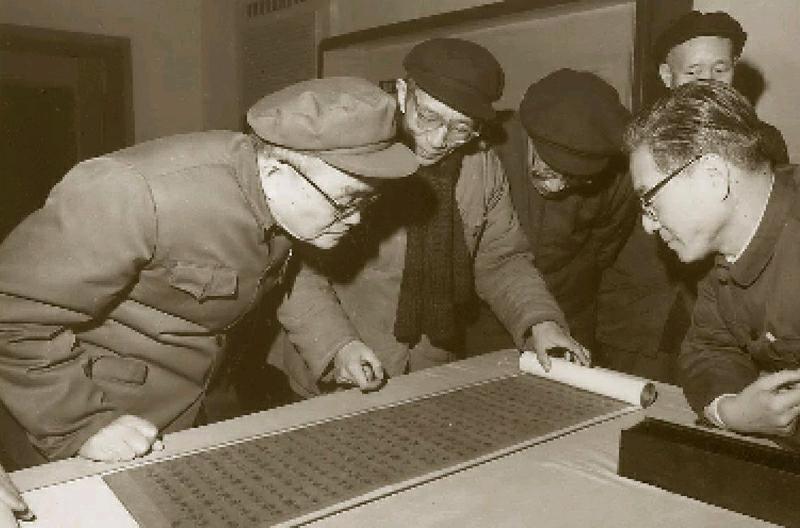黄涌泉:古书画鉴定家的艺术缘
2017-12-09朱明尧
朱明尧
2017年夏,浙江文博界举办了纪念本省已故著名古书画鉴定家、省博物馆资深研究员黄涌泉先生的专题活动。在浙江博物馆展出了他的生平业绩和研究成果图片及翰墨作品,举行了专题座谈会,并在《金石书画》和《西泠艺丛》等专业刊物发表了多篇弘扬和研究黄老的文章。
黄涌泉立足于实践及研究,为浙江的文物鉴定作出了巨大贡献,并有许多学术成果传世。几十年来,全省各地经他过目的书画作品多达十多万件,鉴定出宋朝至清朝的珍贵字画有上千件之多。在此基础上,他撰写发表了许多学术论文,并编辑出版专集,如《八大山人双鸟图考辨》、《书画鉴定浅谈》、《吴镇绘画作品真伪考辨》、《杭州元代石窟艺术》、《浙江历代画家作品选集》(与王伯敏合编)、《浙江近代书画选集》等,尤其是他编的《陈洪绶年谱》深受国内外学者推崇。他的学术视野和鉴定实践立足于浙江,延伸于华东,并影响于国内的文博界。
黄涌泉涉足浙江古书画鉴定后,几乎跑遍了浙江的东南西北。上世纪七十年代后期,他带领几位门生先后赴嘉兴、湖州、宁波、绍兴、台州和舟山等地区的县市,鉴定古书画数以万计,悉心研究,从中抢救出了重要书画和古籍一千余件,定为不同级别的文物,例如,1973年他在绍兴的嵊州进行鉴定时,从一堆当时“抄查”来而被遗弃的废旧书画中发现了一幅《苏武牧羊图》。这幅作品被鉴定为明代著名浙派画家、号称酒仙的陈子和所作(陈原籍为福建浦城),存世作品极为罕见。
当代中国古书画鉴定泰斗、故宫博物院资深研究员徐邦达先生(浙江海宁人1911—2012),于众多古书画鉴定的门生中自认为“最得意”的一位是浙江博物馆资深研究员、古书画鉴定名家黄涌泉先生(浙江嘉善人,已在2003年作古,终年78岁)。
纪念黄涌泉先生,我检看了徐老致我的信函12通、诗文墨宝3件、黄老致函2件及黄老应我之约请而撰的5000字遗文(黄老学生周永良之综合整理稿),探索疏理了黄老在艺术鉴定的长途跋涉中,与他的业师徐邦达之虚心求教和诚意往来,不禁想起了徐、黄师生情谊之佚事。
早在1997年夏,徐老曾客居南京金陵饭店二月余,时在为他于当年7月7日举办的书画个展创作作品及鉴定当地藏品。黄涌泉过往,晤谈甚欢。徐老有感,写下了赠黄先生六首七绝诗,诗之小序中记叙了两人的情谊。
徐邦达和黄涌泉两位先后走上国家、地方的古书画鉴定之岗,自然源于他们早年的艺术喜好和功底,当时客观上也是新中国成立初期文物事业复兴的需要。徐老应郑振铎之召,1950年先至国家文物局后转故宫博物院;黄涌泉则是在1953年8月调到浙江省文物管理局(后转省博物馆)。
徐、黄师生缘启于1955年。当年7月,黄涌泉奉派赴京参加文化部、中国科学院、北京大学联合举办的“第四届考古人员训练班”。到达北京办好报到手续后,他便怀揣着沙孟海先生的推荐信,去故宫博物院拜访徐邦达先生。那时他不过二十多岁,参加文物工作才两年,而徐先生已是蜚声文博界的书画鉴定专家。他站在传达室旁,内心未免有些紧张。只见徐先生缓步出来,他迎上去呈上沙老便函,徐看了以后,面带微笑将他引至办公室叙谈,谈得很契合。那一次黄涌泉在北京两个多月,培训班课余时间,就到故宫皇极殿,宁寿宫及东西庑仔细参观绘画馆数以百计的古代珍品,看不懂的就向徐先生请教。
自此以后,黃涌泉与徐先生多有交往。1962年4月,徐先生到杭州参加有关“中国绘画史”的研讨会。早在1954年故宫绘画馆开放不久,徐先生就发表了《从绘画馆陈列品看我国绘画的发展史》一文,徐先生在这次杭州会议上,更加详尽地表述了自己的论点。会议结束后,徐先生应邀为浙江美术学院图画系作鉴定书画的学术报告,黄涌泉与学生们一起听课做笔记,当时的记录至今还保存着。
1979年9月,徐先生自北京飞抵杭州,故宫杨伯达先生结伴而至,徐先生这时已年近七十了,依然精神矍铄,鹤发松姿,黄先生安排他们住到西子湖畔新新饭店。次日,沙孟海先生与黄涌泉在杭州酒家宴请徐先生。这次徐老来浙,鉴定了浙江博物馆书画数十件,又去杭州市文管会等有关单位鉴定所藏书画。徐先生还常领杨新和黄先生到杭州横紫城巷余任天先生家,鉴定他的书画藏品,得见明黄克晦《金陵八景图册》及黄道周《草书轴》。在杭州期间,黄涌泉又向徐师请教有关明代院画研究问题。徐先生认为明朝宫庭绘画值得进一步研究,随手取出一本故宫业务部书画组编的《明代院体浙派绘画资料》油印本借给黄看。黄先生喜阅数日才归还。徐先生一行离开杭州赴绍兴逗留两天,然后去宁波天一阁考察、鉴定书画,慧眼识珠,鉴定中发现了元四家之一吴镇《双树图》轴,定为吴镇中年的作品。
1983年11月,徐先生至杭州参加西泠印社建社八十周年纪念活动,11月3日上午在学术交流会上,宣读他的《略谈唐宋画所钤的公私印记》论文。数天时间中,黄涌泉始终相伴着徐老。同年12月,黄涌泉应召偕学生周永良赴福建,随侍徐先生鉴定书画。走访了福州、泉州、厦门等地,先后到福建省博物馆、福州市文管会、泉州市文管会、厦门大学人类博物馆、华侨博物馆、郑成功纪念馆等处,共鉴定书画五千余件。半月时光,师生终朝相处,切磋鉴定技艺及学问。
徐、黄两位师生之缘,自是学问传授与吸收,但又有“教学相长”的平等、互补之味。徐先生赠黄的六首七绝中,末首后二句“与君磨切甘附骥,师说无虚此典型。”(此指唐代大文学家韩愈《师说》中“弟子不必不如师,师不必贤于弟子”之意)。有例:1983年冬徐邦达携弟子五六人去福建鉴定半月余之行中,曾有次发现一幅陈洪绶绢本设色秋叶草虫轴,款署“洪绶写于溪山”,徐先生开始觉得很好,定为真迹,因黄涌泉对陈洪绶曾作过很深的研究,对陈洪绶的作品有特别深厚的感情,看得特别仔细,反复地看这幅画,终于看出了问题,黄先生分析说,署款有问题,前后有矛盾,整幅画初看尚不错,但细看红叶,树杆笔法不好,草虫螳螂更劣,虽有几分老莲的面目,功力还是不够,它应是清代前期的“绍兴货”,这幅画可能是郭元宰作的假。后来徐先生又作了细看,说竹叶画得最好,但石头、红叶细看的确弱了点,款写得太肥,认为黄先生的分析有道理,当即改定为赝品。徐先生当着众晚辈的面,否定自己的结论,没有半点不快,黄涌泉为此非常感动。endprint

A series of commemorative events were held in Zhejiang in the summer of 2017 to honor Huang Mingyao (1927-2003), an art appraisal master based in Zhejiang. In the 1970s when the political tumult began to wane and culture began to prosper again, Huang and a group of art appraisers, all being his disciples, traveled across Zhejiang and examined more than 10,000 artworks of painting and calligraphy. They authenticated about 1,000 artworks created in the ancient dynasties. In his lifetime, he examined over 100,000 ancient artworks. Based on his work, he published research papers and jointly compiled art collections of ancient masters.
Xu Bangda (1911-2012), a native of Zhejiang, was one of Chinas best art appraisers in the 20th century. He considered Huang as his best pupil. In my possession are 12 letters to me from Xu, three artworks as gifts to me from Xu, two letters to me from Huang, and a 5,000-word memoir written by Huang at my request and eventually edited by his protégé Zhou Yongliang. Having read these texts carefully, i am under the impression that Huang worked hard at appraisal, that he learned a great deal from Xu, and that there was a great friendship between the two.
In the summer of 1997, Xu Bangda stayed at Jinling Hotel in Nanjing for over two months. He was there for such a long period for two reasons. In July, he attended an exhibition of his artworks of painting and calligraphy in Nanjing. And he appraised artworks brought to him by local collectors. Huang went to Nanjing to visit Xu. The visit was delightful for the two appraisers. They chatted. Xu wrote six short poems to commemorate the reunion.
The two first met in July 1955. In 1950, Xu became a national appraiser based in the Forbidden City in Beijing and Huang was employed by Zhejiang Administration of Cultural Relics in August 1953 and soon was transferred to Zhejiang Museum as an art appraiser. In 1955, he came to Beijing to attend an advanced study course for young archaeologists. Sha Menghai, a prominent calligrapher based in Zhejiang, wrote a letter of referral for Huang. Huang brought the letter to Beijing and visited Xu Bangda. In Xus office, the two had a long talk and the master liked the young scholar. During the 2-month course, Huang found time to visit the Forbidden City and viewed hundreds of artworks in the imperial collection thanks to the arrangement by Xu. If he had some difficulty understanding the artworks he was viewing, Huang consulted the master and got answers.endprint
In September 1979, Xu Bangda and Yang Boda, another scholar working for the Forbidden City, came to Hangzhou. They had come to appraise dozens of artworks in the collection of Zhejiang Museum. In the accompaniment of Huang, they visited Yu Rentian, a local collector, and examined his private collection. Huang consulted Xu on some key issues in his study of the imperial art academy of the Ming Dynasty and Xu let Huang read a booklet on the Zhejiang-style paintings in the academic style during the Ming. The booklet had been published and circulated within a small circle of scholars and experts.
In the following years, Huang and Xu traveled together several times on appraisal missions in Zhejiang and Fujian. Huang learned a lot from Xu. And Xu also absorbed some ideas from Huang. Judging from what they did together on these missions, it can be said that the two enjoyed a teacher-student relationship.
In December 1983, Xu Bangda and Huang went to Fujian on an appraisal mission for about half a month. One of the works they examined was a painting in color on silk. Xu thought it was an authentic masterpiece by Chen Hongshou (1599-1652), a painter of the Ming Dynasty. With a profound expertise on the Ming painter and passion for the artists artworks, Huang scrutinized the artwork many times and then spotted some wrong details. He suggested that it was a painting faked by an artist in the early decades of the Qing (1644-1911). Xu found Huangs analysis was convincing and agreed frankly that it was a fake in front of his students. Huang was touched by his masters candor and integrity in admitting that he had been wrong.endprint
